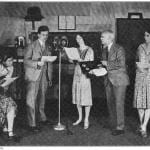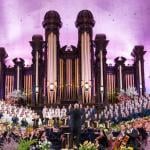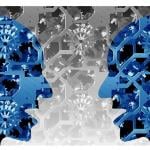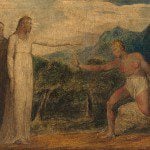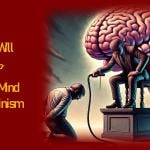
In sacrament meeting on Sunday morning, my ward sang one of the new hymns that will eventually be included in the revised hymnal of the Church of Jesus Christ of Latter-day Saints. It is entitled “Bread of Life, Living Water.”
Along with many other such hymns and, for that matter, very many other aspects our belief and practice, I think that lyrics such as these of “Bread of Life, Living Water” place those who seek to depict us as non-Christians under a very heavy burden.
Many years ago, the Rev. Jeffrey Silliman was the respondent to a paper that I presented at that year’s Sunstone Symposium. My paper argued that none of the reasons commonly given by Evangelical Protestants and some others for claiming that Latter-day Saints aren’t Christians hold up to logical and historical scrutiny. (That paper eventually became the core of the book Offenders for a Word.)
“I get the impression,” Rev. Silliman commented, “that Professor Peterson wouldn’t be bothered nearly as much if I were to pronounce him a heretic as he is by people calling him a non-Christian.” In saying that, Rev. Silliman was quite perceptive and precisely right. Calling someone or something “heretical,” it seems to me, clearly presumes a particular theological standpoint from which the judgment is being pronounced. Calling someone a non-Christian, by contrast, seems an objective description — which it may or may not actually be. (In the case of Evangelical Protestants declaring Latter-day Saints — or Catholics [believe it or not, I’ve actually heard this!] — to be non-Christians, it is a subjective and biased judgment masquerading quite illegitimately as a purely rational and objective one.)
By the way, I recall with fondness an Evangelical in Southern California who faulted me for my hypocrisy and double standard: I wanted to be called a Christian, she said, while at the same time I flatly denied the right of Muslims to be Christians. I decided that a conversation on this particular topic with such a person was never likely to go anywhere or to achieve anything, so I politely bowed out of it.

On the flight from Salt Lake City over to Portland — which afforded the usual marvelous view of majestic, volcanic Mt. Hood — I read through most of the Journal for Near-Death Studies 41/1 (Spring 2023). (Like many other academic journals, it’s significantly behind on its publication schedule.) I want to share a few of my gleanings from two of the articles with you here:
(1) Pim van Lommel and Bruce Greyson, “Critique of Recent Report of Electrical Activity in the Dying Human Brain” (3-8). Respectively a cardiologist at the Rijnstate Hospital in Arnhem, The Netherlands, and the Chester Carlson Professor Emeritus of Psychiatry and Neurobehavioral Sciences at the University of Virginia Health System in Charlottesville, Virginia, Drs. van Lommel and Greyson are responding here to certain interpretations of a recent research report about surprising electrical activity detected in the brains of a pair of comatose patients at the University of Michigan’s academic medical center who died shortly thereafter. Some commentators have jumped to the conclusion that near-death experiences have now been accounted for and explained away.
In my judgment, Van Lommel and Greyson convincingly rebut such claims. Much of their argument rests on particular moderately technical medical arguments. To me, though, their most persuasive counterargument is the one that I myself, far from a trained medical specialist, would have made. Even setting aside their medical reasoning, they write, and giving the report the widest possible application to NDEs, nothing remotely approaching an explanation of near-death experiences is apparent in the report at issue:
Whereas such studies may contribute to an understanding of the mechanisms through which the brain processes phenomena such as NDEs, they do not address the cause of NDEs.
For example, as you, the reader, read the words on this page, nerve cells in your eyes send electrical signals to the vision center of the occipital lobe of your brain and to the language center of your temporal lobe. But the electrical activity in your nerve cells did not cause the words to appear on this page; they merely enabled you to see and understand them.
Likewise, regarding the well-documented phenomena of NDEs, understanding electrical processes in the brain might elucidate the mechanisms whereby experiencers process their memories and interpretations of the NDEs. However, electrical processes do not and cannot explain what enables unconscious patients to see unexpected things in the material world accurately from an out-of-body visual perspective; to recognize and interact with deceased persons who, in the material world, were not yet known to have died; or to experience greatly enhanced cognition and perception during cardiac arrest or general anesthesia when neuroscientific models deem such complex consciousness to be impossible. (5-6; internal references omitted)
(2)
Alex A. Álvarez, Rodrigo Arriolo-Godoy, and Ramsés D’León, “Near-Death Experiences, Post-Traumatic Stress, and Supernormal Abilities in a Latin American Sample” (40-66)
The authors, who are all affiliated with the Unidad Parapsicológia de la Investigación, Difusión y Enseñanza (UPIDE) in Mexico City, conducted a study of Spanish-speaking near-death experiencers from Latin America, mostly from Mexico, and a small number from Spain.
Most NDE research to date has involved English-speaking samples. (51)
Overall, similarity of our participants’ responses to responses of participants in previous studies of predominantly English-speakiing samples contributes to a growing perspective of the similarity of NDE features and aftereffects across cultures. (40)
NDEs are experienced independent of people’s culture or religion. Researchers analyzing the experiences of people around the world have found core phenomenological aspects. However, the content of the visions that occur throughout NDEs does seem to be related to or interpreted through the dominant culture and/or religion that the near-death experiencer (NDEr) identifies with. (41; internal references omitted)
I will return to the article by Álvarez, Arriolo-Godoy, and D’León in the next day or two. It’s been a long day, and I suddenly realize that I’m nearing my limit.
Posted from Depoe Bay, Oregon



